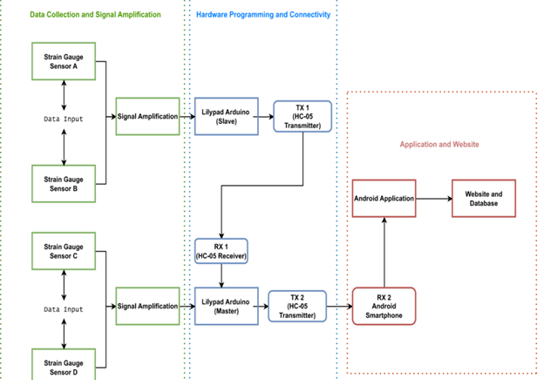PORTABLE EDEMA MONITORING SYSTEM
In this section, I will briefly explain the general idea of this project, which, incidentally, was my graduation project. In this project, I applied the necessary engineering skills to build a comprehensive project, starting with the initial report outlining the requirements and progressing to the technical aspects and presenting the final form of the project.
ABOUT THE PROJECT
Edema is generally defined as a swelling under the skin caused by accumulation of fluids. This can be caused by many medical reasons. Peripheral edema is a type of swelling that happens in peripheral organs (legs, hands, feet arms). Most peripheral edema patients get edema in the legs. In this project we are specifically targeting bilateral peripheral edema which is almost a symmetrical swelling in both legs. Bilateral edema is directly linked to major chronic diseases in most cases, thus the change in the swelling severity is also an indication of the deterioration or improvement of the patient’s disease. The change in the extent of the swelling most of the times can’t be felt or noticed by the patient as it is very small, and the need to go and visit a doctor’s clinic daily to monitor that change can be bothersome, especially for peripheral edema patients as walking and mobility in general is greatly limited by the swelling. Through the use of a portable system, we can implement an engineering design that can monitor the swelling severity and store the data taken in a cloud-based system so both the doctor and the patient can access the patient’s history through a website
SITUATION DESCRIPTION
A small device that can measure the extent of the swollen area of patient who suffer from edema, the device will collect measurements over a set period of time and send it to a server to be processed and then accessed by the patient or the doctor. The device will connect to a server wirelessly for any abnormality’s measurement will be detected by the device and display.
PROBLEM STATEMENT
Edema disease is a swelling caused by the retention and accumulation of excess fluids. Edema often spreads to the extremities of the body, such as the hands and feet, and is more in the feet, and it might be a sign of serious medical conditions, including congestive heart failure, high blood pressure, and kidney failure. Sitting or standing for prolonged amounts of time can also cause Edema on the feet (peripheral Edema). Based on recent studies, 19% to 20% of people older than 51 years’ experience edema at least once. and 80% of pregnant women develop Edema in their pregnancy. It is hard to actively monitor Edema by physicians and this project aims to utilize modern technology to develop an IoT (Internet of Things) system to monitor Peripheral Edema that can be used by patients and their doctors to track any changes in the applied area.
IMPLEMENTATION
1-DATA COLLECTION AND SIGNAL AMPLIFICATION
For the system to be functioning correctly and accurately, the circuit design needs to be well-researched. Our system consists of two microcontrollers acting as 35 a master and slave, four strain gauge sensors, 4 amplifier circuits and 3 Bluetooth modules. The most important thing is the amplifying circuit and how the signal will be presented in the microcontroller.
2-HARDWARE PROGRAMMING AND CONTECTIVITY
This task is to ensure the seamless integration and reliable operation of this duo, it is essential to have a well-structured test procedure in place. This test procedure aims to outline the systematic steps and checks needed to verify the correct functionality and performance of the Arduino and HC-05 module, ensuring that they work in harmony to meet the project's requirements.
BRODER IMPACTS
Social Impact: The effects revolve around abandoning the idea of traditional measurements of edema disease and replacing it with a more professional quality and accurate electrical system which helps reduce the burden on hospitals.
Economic Impacts: The economic impact is represented by replacing traditional measurement methods that require attendance at the hospital with an electronic alternative that send the data remotely which saves the costs of commuting to hospitals and taking valuable doctor and clinic time and resources.
Safety: The system contains a Lithium battery which can be a fire hazard if punctured or mistreated, to prevent this the battery was placed in a fabric material with a hard material over it. Also, all the electronics were placed in a fabric pouch to prevent electric shock.
CONCLUSION
The portable edema monitoring system project was done starting with choosing a suitable sensor and a wearable design, then designing the electronic circuit and then optimizing the system further theoretically before starting the practical work. After starting the practical work, a lot of testing and trial and error experiments were made to get the result that we have now. the strain gauge sensor used granted our prototype accurate reproducible results. Also, the development of the companion app made the project easy to use and interface with. We faced some challenges regarding the mechanical design of the wearable biomedical system, but with a lot of trial and error we produced a solution that satisfies our customer needs and a product that is aesthetically pleasing for a prototype. the system achieved its portability by using a unique wearable design that can be attached on the socks using Velcro and storing all the electronic components and battery in a small removable pouch

